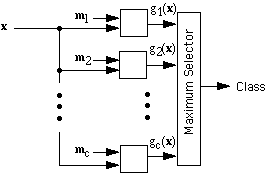

Notice that the x'x term is the same for every class, i.e.,
for every k. To find the template mk that minimizes
|| x - mk ||, it is sufficient
to find the mk that maximizes the bracketed
expression, mk' x - 0.5 mk'
mk. Let us define the linear discriminant
function g(x) by
Then we can say that a minimum-Euclidean-distance clasifier classifies
an input feature vector x by computing c linear discriminant
functions g1(x), g2(x),
... , gc(x) and assigning x
to the class corresponding to the maximum discriminant function. We can
also think of the linear discriminant functions as measuring the correlation
between x and mk, with the
addition of a correction for the "template energy" represented
by || mk ||2. With this correction
included, a minimum-Euclidean-distance classifier is equivalent to a maximum-correlation
classifier.

![]() Back to Inner Prod.
Back to Inner Prod. ![]() On to Boundaries
On to Boundaries ![]() Up to Simple Classifiers
Up to Simple Classifiers